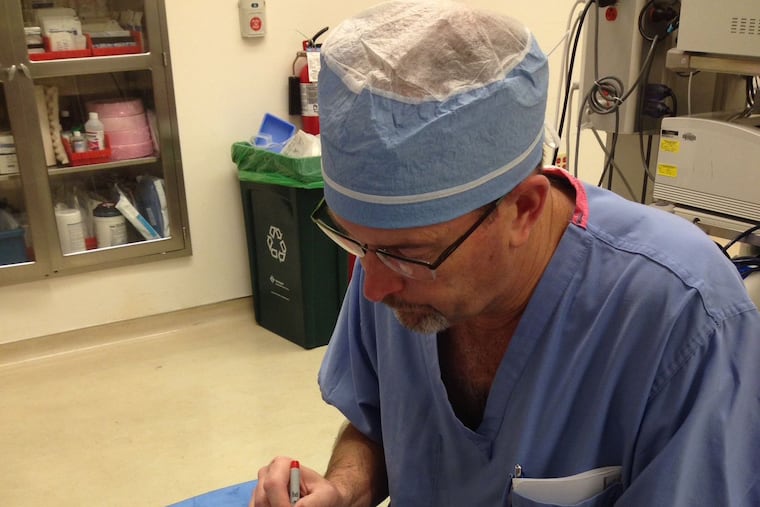Pediatric surgeon heals patients with art and medicine
From SpongeBob to Spider-Man and bears to butterflies, there isn’t much Dr. Robert Parry hasn’t drawn.

One of the most traumatic days of Susan McFrederick’s life was watching her son, Witt, get wheeled away for surgery to fix a ruptured intestine hours after he was born in 2011.
But after the operation at Akron Children’s Hospital in Ohio, McFrederick, a mother of six, and her husband, Rodd McFrederick, burst into tears for a different reason: Across the incision on their newborn son’s belly was a sweet winter scene, hand-drawn on his bandages.
“There were rolling hills of snow, a pine tree, and a snowman with a hat and broom, cut out separately and put down layer by layer,” she recalled. “It was extremely touching and comforting to know that somebody had taken the time to do that for my family. It was a moment I’ll never forget.”
The McFredericks soon learned the artist was Witt’s surgeon, Robert Parry, who had discovered another way to use his hands in the mid-1980s during his pediatric surgery internship at what is now called Walter Reed National Military Medical Center in Bethesda, Md.
A surgeon whom Parry considered a mentor had cut out heart and shark shapes to decorate children’s bandages, and Parry, who had always enjoyed doodling and drawing, decided to follow suit, he said.
“My first reaction when I initially saw him cut out these hearts and sharks was, ‘What is he doing? Hey, that’s kind of neat,’” Parry recalled. “I especially liked the reactions of the parents and the patients when they saw his artwork. The smiles distracted everyone from the surgery.”
Parry worked in Bethesda as a general surgeon intern in 1985 and 1986 before joining the Marines, with tours in the Caribbean and Mediterranean. Beginning in 1988, he spent six years finishing his general surgery residency at the military hospital.
» READ MORE: A scammer swindled her out of $18,000 - but a spaghetti dinner got it back
» READ MORE: These students danced for 46 hours straight and raised $11.7 million for kids' cancer research
During the last 30 years, he estimates, he has left examples of his handiwork over the stitches of more than 10,000 children, mostly in Ohio, where he has spent most of his career. Examples of his post-surgery artwork can be found in patients’ scrapbooks and hospital Facebook posts.
“I imagine there are lots of families who carry love in their hearts for Dr. Parry,” said Susan McFrederick, 45, who found a pair of spouting whales on her son’s bandages after a follow-up surgery.
Parry, 61, graduated quickly from his early hearts and sharks at the Bethesda hospital and decided to surprise families with drawings that captured young patients’ personalities. From SpongeBob to Spider-Man and bears to butterflies, there isn’t much he hasn’t drawn.
“There was a girl once who really wanted a cheeseburger, but couldn’t eat after surgery, so she woke up and found a cheeseburger drawn on her bandage,” he recalled. “And another time, when I took a bullet out of a child, I drew a gun inside a circle with a red line across it.”
Most kids, though, want superheroes, sports team logos, or princesses, said Parry, while infants often receive scenes with flowers, trees, and sea creatures. Long-necked giraffes are perfect for covering vertical stitches, he said.
Holiday scenes of valentine hearts, witches on brooms, Thanksgiving turkeys, or festive snowmen are particularly popular at certain times of the year.
“During a time of stress for families, it’s nice to be able to help them smile and laugh,” Parry said. “This is something positive that I can do for them, which is what I like most about it.”
For patients who are critically ill, he is careful to draw something simple — usually a red heart.
“Those are tough. You don’t want to pretend that nothing else is going on,” he said. “When there’s something that you can’t fix, that’s super sad. But thankfully, for most of them, we can redirect the bus a bit and help them along.”
For Heather Vincent of Cuyahoga Falls, Ohio, finding a Buzz Lightyear bandage on her 3-year-old son after Parry removed tumors on his vena cava, gallbladder, and liver made a difference.
“It was such a major surgery and to see him in the ICU with tubes coming out of him and a drain up his nose was overwhelming,” said Vincent of her son Jackson Kunze, now 7. “When a nurse said, ‘I want to show you something’ and lifted up Jackson’s gown to show me Buzz Lightyear, it was an instant happy distraction from everything else that was going on.”
For Parry, the reward is knowing he hopefully made a difference in a child’s life; except for snapshots of his bandages, “they can go on and live their lives and never know I was in it,” he said.
He’s not ready to retire, but he’s found a new hobby to help with his dexterity in the years to come.
“I’ve taken up knitting,” Parry said. “Hats, sweaters, scarves, fingerless gloves — I enjoy it all. But mostly, I enjoy giving everything away.”